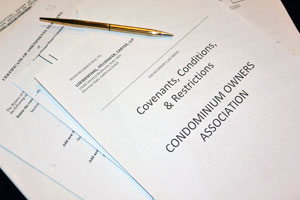LHC Newsletter Vol. 9, No. 1
“2016/2017: NEW LAWS & LEGISLATION IMPACTING HOMEOWNER’S ASSOCIATIONS
STATE LEGISLATION AND LAWS:
By: Robert D. Hillshafer
David A. Loewenthal
Barbara A. Higgins
Civil Code § 4775 (Effective January 1, 2017) (aka AB 968)
Responsibility for repair, replacement, or maintenance
Effective: January 1, 2017
Significance: The new version of Civil Code § 4775 (below) is a long-awaited legislative clarification regarding the issue of owner versus association responsibilities as to separate interests and exclusive use common areas. The new version now clearly provides that the Association shall have the obligation to repair and replace exclusive use common area and the owners simply “maintain” it. Though not defined in the statute, “maintenance” is generally more of a cosmetic or appearance issue rather than a functionality or structural issue.
(a) (1) Except as provided in paragraph (3), unless otherwise provided in the declaration of a common interest development, the association is responsible for repairing, replacing, and maintaining the common area.
(2) Unless otherwise provided in the declaration of a common interest development, the owner of each separate interest is responsible for repairing, replacing, and maintaining that separate interest.
(3) Unless otherwise provided in the declaration of a common interest development, the owner of each separate interest is responsible for maintaining the exclusive use common area appurtenant to that separate interest and the association is responsible for repairing and replacing the exclusive use common area.
(b) The costs of temporary relocation during the repair and maintenance of the areas within the responsibility of the association shall be borne by the owner of the separate interest affected.
(c) This section shall become operative on January 1, 2017. (Emphasis added.)
[NEW] Civil Code § 4777 (aka AB 2362)
Common Interest Developments: Pesticide-Notification
Significance: This new law requires an Association or an authorized agent to provide specific notice to homeowners and tenants about the use of pesticides, and identify it as a toxic substance, when the Association or its agent applies any pesticide without a licensed pest control operator at the owner or tenant’s dwelling unit or in common areas.
Summary: The law specifies the contents of the pesticide notice to owners and tenants, as well as a notification procedure. It allows for signs to be posted in areas where pesticides are being applied by unlicensed pest control persons. If there is threat of immediate harm by the pest, such as a bee swarm, which makes prior notification unreasonable, then written notice may be posted as soon as practical, but not later than one hour after the pesticide is applied.
While Civil Code ¶ 4777 (a) contains important definitions, subpart (b) lays out the procedures and language to be used when giving notice, as follows:
(b) (1) An association or its authorized agent that applies any pesticide to a separate interest or to the common area without a licensed pest control operator shall provide the owner and, if applicable, the tenant of an affected separate interest and, if making broadcast applications, or using total release foggers or aerosol sprays, the owner and, if applicable, the tenant in an adjacent separate interest that could reasonably be impacted by the pesticide use with written notice that contains the following statements and information using words with common and everyday meaning:
(A) The pest or pests to be controlled.
(B) The name and brand of the pesticide product proposed to be used.
(C) “State law requires that you be given the following information:
CAUTION – PESTICIDES ARE TOXIC CHEMICALS. The California Department of Pesticide Regulation and the United States Environmental Protection Agency allow the unlicensed use of certain pesticides based on existing scientific evidence that there are no appreciable risks if proper use conditions are followed or that the risks are outweighed by the benefits. The degree of risk depends upon the degree of exposure, so exposure should be minimized.
If within 24 hours following application of a pesticide, a person experiences symptoms similar to common seasonal illness comparable to influenza, the person should contact a physician, appropriate licensed health care provider, or the California Poison Control System (1-800-222-1222).
For further information, contact any of the following: for Health Questions – the County Health Department (telephone number) and for Regulatory Information – the Department of Pesticide Regulation (916-324-4100).”
(D) The approximate date, time, and frequency with which the pesticide will be applied.
(E) The following notification:
“The approximate date, time, and frequency of this pesticide application is subject to change.”
(2) At least 48 hours prior to application of the pesticide to a separate interest, the association or its authorized agent shall provide individual notice to the owner and, if applicable, the tenant of the separate interest and notice to an owner and, if applicable, the tenant occupying any adjacent separate interest that is required to be notified pursuant to paragraph (1).
(3) (A) At least 48 hours prior to application of the pesticide to a common area, the association or its authorized agent shall, if practicable, post the written notice described in paragraph (1) in a conspicuous place in or around the common area in which the pesticide is to be applied. Otherwise, if not practicable, the association or its authorized agent shall provide individual notice to the owner and, if applicable, the tenant of the separate interest that is adjacent to the common area.
(B) If the pest poses an immediate threat to health and safety, thereby making compliance with notification prior to the pesticide application unreasonable, the association or its authorized agent shall post the written notice as soon as practicable, but not later than one hour after the pesticide is applied.
(4) Notice to tenants of separate interests shall be provided, in at least one of the following ways:
(A) First-class mail.
(B) Personal delivery to a tenant 18 years of age or older.
(C) Electronic delivery, if an electronic mailing address has been provided by the tenant.
(5) (A) Upon receipt of written notification, the owner of the separate interest or the tenant may agree in writing or, if notification was delivered electronically, the tenant may agree through electronic delivery, to allow the association or authorized agent to apply a pesticide immediately or at an agreed upon time.
(B) (i) Prior to receipt of written notification, the association or authorized agent may agree orally to an immediate pesticide application if the owner or, if applicable, the tenant requests that the pesticide be applied before the 48-hour notice of the pesticide product proposed to be used.
(ii) With respect to an owner or, if applicable, a tenant entering into an oral agreement for immediate pesticide application, the association or authorized agent, no later than the time of pesticide application, shall leave the written notice specified in paragraph (1) in a conspicuous place in the separate interest or at the entrance of the separate interest in a manner in which a reasonable person would discover the notice.
(iii) If any owner or, if applicable, any tenant of a separate interest or an owner or, if applicable, a tenant of an adjacent separate interest is also required to be notified pursuant to this subparagraph, the association or authorized agent shall provide that person with this notice as soon as practicable after the oral agreement is made authorizing immediate pesticide application, but in no case, later than commencement of application of the pesticide.
(6) A copy of a written notice provided pursuant paragraph (1) shall be attached to the minutes of the board meeting immediately subsequent the application of the pesticide.
[AMENDED] Civil Code §6000 (aka AB 1963)
HOA/Construction Defect Law
Under existing law, the Davis-Stirling Common Interest Development Act requires until July 1, 2017, specified conditions to be met relative to attempts to resolve construction defect claims before an association may file a complaint for damages against a builder, developer or general contractor based upon a claim for defects in the design or construction of the common interest development. This law has now been extended until July 1, 2024.
Civil Code §5300 (aka AB 596)
Annual Budget Reports
Beginning July 1, 2016, condominium associations, as part of their Annual Budget Reports, must disclose in separate statements (separate paper) using 10 point font their status as FHA [Federal Housing Administration] approved and as a VA [federal Department of Veterans Affairs] approved condominium project, where applicable. This does not apply to planned unit developments.
SB 918 [An act to add Section 4041 to the Civil Code]
Annual Address Updates for Association Notices
Summary: This new law requires homeowners to annually verify their address or the addresses to which the association notices are to be delivered, and to specify whether the home is owner-occupied, rented out, vacant or undeveloped. If a homeowner does not comply each year, notices will be deemed delivered to the owner’s property address. The statute does not address the consequences of the Association’s failure to solicit the information annually. The new statute reads as follows:
Civil Code § 4041
(a) An owner of a separate interest shall, on an annual basis, provide written notice to the association of all of the following:
(1) The address or addresses to which notices from the association are to be delivered.
(2) An alternate or secondary address to which notices from the association are to be delivered.
(3) The name and address of his or her legal representative, if any, including any person with power of attorney or other person who can be contacted in the event of the owner’s extended absence from the separate interest.
(4) Whether the separate interest is owner-occupied, is rented out, if the parcel is developed but vacant, or if the parcel is undeveloped land.
(b) The association shall solicit these annual notices of each owner and, at least 30 days prior to making its own required disclosure under Section 5300, shall enter the data into its books and records.
(c) If an owner fails to provide the notices set forth in paragraphs (1) and (2) of subdivision (a), the property address shall be deemed to be the address to which notices are to be delivered.
SB 3: Minimum Wage Amendments to Labor Code
Expense Impact on Association, its Workers and Vendors
Minimum wage is scheduled to increase for all industries over the next six years. The current minimum wage is at least $10 per hour. Increases are progressive, depend on number of employees, and will be subject to annual determination. This legislation will likely affect the cost of doing business for Associations.
Automatic Installation of Board Members. (Proposed but failed)
AB 1799 — An act to amend Sections 5100, 5105, and 5145 of the Civil Code.
The California Legislative Action Committee (CLAC) fought hard for the passage of this bill which would have allowed candidates to be automatically installed as board members when the number of candidates was fewer or equal to the number of open seats. Although it passed the full assembly, it was vigorously opposed by anti-HOA groups which claimed it was unconstitutional.
FEDERAL LEGISLATION:
HR 3700 – Housing Opportunity Through Modernization Act of 2016
FHA Condominium Certification Process
On July 29, 2016, President Obama signed into law, legislation which unanimously passed in both the U.S. House and Senate, FHA condominium rules (1) reducing the FHA condo owner occupancy rate down to 35%, (2) directing the FHA to streamline the condo re-certification process, (3) provide more flexibility for mixed use buildings, and (4) make reforms to federally assisted housing programs to streamline programs involving Title I, Section 8, among other directives.
This legislation should make it easier to obtain a FHA loan.
24 CFR Part 100: Discriminatory Conduct Under the Federal Housing Act
Currently, this law provides rules regarding discriminatory conduct under the FHA. Effective October 14, 2016, the regulations are amended to formalize the standards used in the housing context to evaluate claims of hostile environment and harassment. It defines “quid pro quo harassment” and “hostile environment harassment” as being prohibited under the FHA, and specifies evaluation standards concerning whether conduct is in violation.
(a) General. Quid pro quo and hostile environment harassment because of race, color, religion, sex, familial status, national origin or handicap may violate sections 804, 805, 806 or 818 of the Act, depending on the conduct. The same conduct may violate one or more of these provisions.
(1) Quid pro quo harassment. Quid pro quo harassment refers to an unwelcome request or demand to engage in conduct where submission to the request or demand, either explicitly or implicitly, is made a condition related to: The sale, rental or availability of a dwelling; the terms, conditions, or privileges of the sale or rental, or the provision of services or facilities in connection therewith; or the availability, terms, or conditions of a residential real estate-related transaction. An unwelcome request or demand may constitute quid pro quo harassment even if a person acquiesces in the unwelcome request or demand.
(2) Hostile environment harassment. Hostile environment harassment refers to unwelcome conduct that is sufficiently severe or pervasive as to interfere with: The availability, sale, rental, or use or enjoyment of a dwelling; the terms, conditions, or privileges of the sale or rental, or the provision or enjoyment of services or facilities in connection therewith; or the availability, terms, or conditions of a residential real estate-related transaction. Hostile environment harassment does not require a change in the economic benefits, terms, or conditions of the dwelling or housing-related services or facilities, or of the residential real-estate transaction.
(i) Totality of the circumstances. Whether hostile environment harassment exists depends upon the totality of the circumstances.
(A) Factors to be considered to determine whether hostile environment harassment exists include, but are not limited to, the nature of the conduct, the context in which the incident(s) occurred, the severity, scope, frequency, duration, and location of the conduct, and the relationships of the persons involved.
(B) Neither psychological nor physical harm must be demonstrated to prove that a hostile environment exists. Evidence of psychological or physical harm may, however, be relevant in determining whether a hostile environment existed and, if so, the amount of damages to which an aggrieved person may be entitled.
(C) Whether unwelcome conduct is sufficiently severe or pervasive as to create a hostile environment is evaluated from the perspective of a reasonable person in the aggrieved person’s position.
(ii) Title VII affirmative defense. The affirmative defense to an employer’s vicarious liability for hostile environment harassment by a supervisor under Title VII of the Civil Rights Act of 1964 does not apply to cases brought pursuant to the Fair Housing Act.
(b) Type of conduct. Harassment can be written, verbal, or other conduct, and does not require physical contact.
(c) Number of incidents. A single incident of harassment because of race, color, religion, sex, familial status, national origin, or handicap may constitute a discriminatory housing practice, where the incident is sufficiently severe to create a hostile environment, or evidences a quid pro quo.


